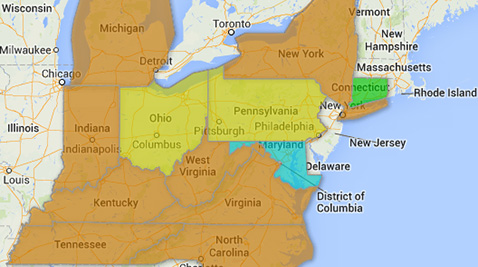COLLEGE PARK — A large percentage of Maryland’s air pollution could be reduced after the Supreme Court ruled last month that the EPA has the authority to regulate emissions that cross state borders.
The Environmental Protection Agency’s Cross-State Air Pollution Rule, part of the federal Clean Air Act, aims to hold power plants accountable for their emissions that are blown to downwind states. The rule requires that they lower emissions of sulfur dioxide, which can form fine particulate matter, and nitrogen oxide, which can form ozone and fine particulate matter.
The EPA created the rule in 2011, but it was blocked from enforcing it in 2012 by a federal appeals court decision. The Supreme Court decision tasked the federal appeals court with determining how the rule will be implemented, said Josh Berman, staff attorney for the Sierra Club.
Up to 70 percent of Maryland’s ozone pollution comes from out of state, according to Maryland Gov. Martin O’Malley.
“Ozone transported into the State has been measured at levels that already violate health-based standards,” O’Malley said in a statement. “The science clearly demonstrates that Maryland cannot fully meet the air quality standards that protect public health unless air pollution generated outside of our State’s borders is controlled.”
Maryland contributes fine particulate matter and ozone to Pennsylvania and fine particulate matter to Ohio. 10 states — Pennsylvania, Ohio, Michigan, Indiana, Kentucky, Tennessee, North Carolina, Virginia, West Virginia and New York — contribute ozone pollution to Maryland.
Ozone is an important component of the atmosphere, helping to repel sunlight that would otherwise get trapped inside the atmosphere and heat it up. However, when excess ozone builds at ground level, it can exacerbate health issues such as asthma. Fine particulate matter is a mixture of extremely small particles that can also cause health problems when inhaled.
The American Lung Association ranked Washington, Baltimore and Arlington, Virginia, together as the eighth-worst city for ozone pollution in the U.S. this year.
A Massachusetts Institute of Technology study found that there are 1,885 premature deaths tied to power plant pollution each year in Maryland, the 12th highest rate in the nation.
One way that Maryland has sought to improve air quality is through the renewable energy portfolio standard, which provides state credits to companies using renewable energy sources like wind and solar. James McGarry, chief policy analyst for the Chesapeake Climate Action Network, said that this can reduce emissions of greenhouse gases and other forms of pollution that harm air quality.
Maryland is also a member of the Regional Greenhouse Gas Initiative, a collaboration between nine states in the Northeast designed to reduce greenhouse gas emissions from power plants on a regional scale.
In order to reduce the damaging effects of emissions, power plants in Maryland have invested about $2.6 billion in pollution controls, such as scrubbers that remove pollutants from coal-burning plants, and “it worked,” said George “Tad” Aburn, director of the Maryland Dept. of the Environment’s Air and Radiation Management Administration.
“The controls went in, the emissions went down, and at least the standards they were designed to help us meet, we met those standards,” Aburn said. “I’ve worked here at MDE for 30 years, and this is the first time in my 30-year career that I can say we’re in full compliance with the federal health standards for fine particulates.”
The new EPA rule will likely reduce ozone levels in Maryland that currently exceed EPA standards, McGarry said.
“It’s a really good step and I recognize that there’s a limit to what downwind states can do to reduce air pollution that is disproportionately affecting [their] own citizens,” McGarry said. “This sort of corrects that imbalance between those suffering from emissions and those producing the emissions.”
Until the federal appeals court determines final details of the rule and removes the stay on it, there are no specific figures for what lower emission levels that states — including Maryland — need to achieve.
“We have a real challenge,” Aburn said. “We can do everything we can within our borders, but unless we get reductions in upwind states, we may never meet the standards because what’s coming in is already above them.”

